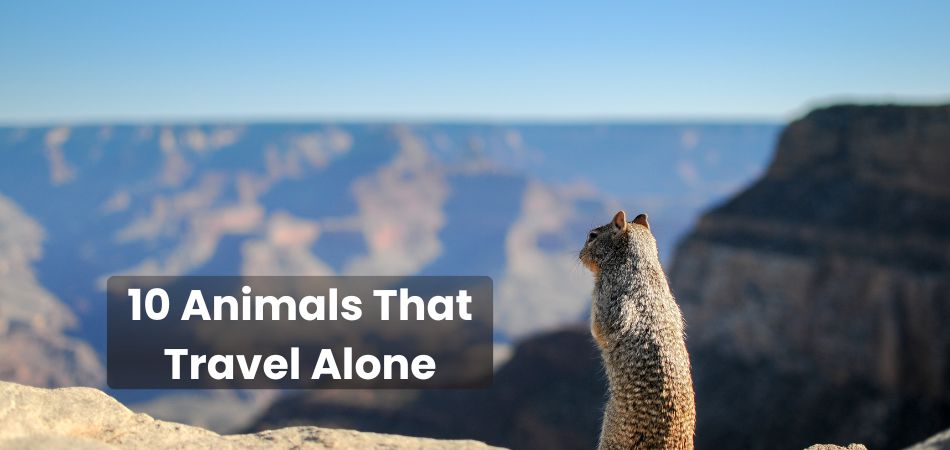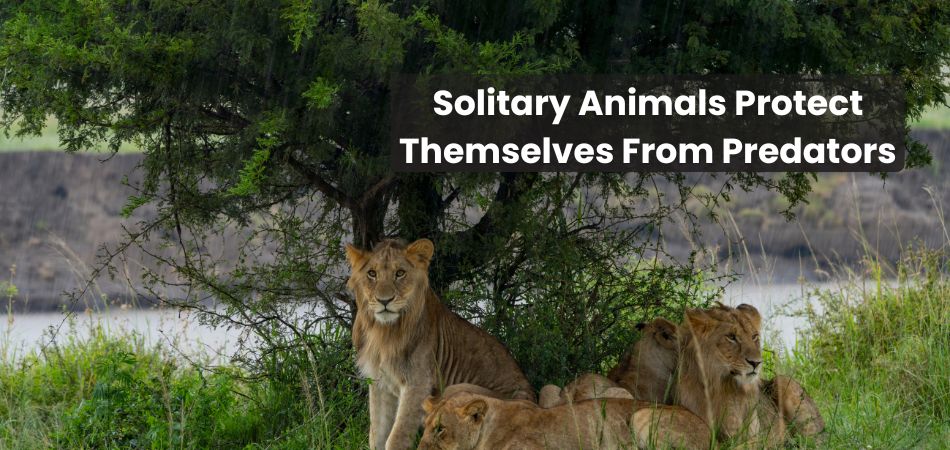There are many creatures in the vastness of the natural world, not all creatures live in groups or herds. While many animals rely on packs for survival, some have developed the skill of solitude. These rare species exhibit independence, traveling alone to hunt, explore, or migrate across challenging terrains.
Our discussion focused on 10 animals that travel alone to demonstrate resilience, strength, and adaptability, proving that solitude can be a powerful survival strategy.
Some animals, like leopards, polar bears, and great white sharks, live in solitude, using stealth, strength, and adaptability to survive and dominate their environments without relying on groups or companionship.
Take a look at the intriguing lives of these lone adventurers and explore the secrets of their solitary journeys.
What Makes These Animals Prefer Solitary Journeys?
Some animals are natural loners, preferring a life of independence over group living. Their solitary journeys are often driven by survival strategies, instinct, and adaptation to their environments. Below, we explore the key reasons why these creatures thrive alone, highlighting their distinctive traits and behaviors.

Limited Resources and Competition
In many habitats, resources like food, water, and shelter are scarce. Traveling alone allows these animals to avoid competition and meet their survival needs. By staying solitary, they maximize their chances of finding enough to sustain themselves.
Predatory Instincts and Stealth
For many predators, hunting alone offers a strategic advantage. Solitary movement reduces noise and increases the chances of ambushing prey without being detected. Their ability to rely on their own instincts makes them efficient hunters in the wild.
Territorial Nature and Defense
Some animals are highly territorial and prefer solitude to protect their space. Defending their territory allows them to secure food, mating opportunities, and shelter without sharing. Solitary living minimizes conflict and ensures survival in competitive ecosystems.
Adaptation to Harsh Environments
Certain environments are better suited to solitary animals because they require special survival skills. Traveling alone helps these creatures conserve energy and navigate challenging conditions like deserts, dense forests, or open oceans. Isolation becomes a strength in places where only the fittest survive.
Self-Reliance for Survival
For many solitary animals, independence is a vital survival trait. They develop strong instincts, sharp skills, and adaptability to survive without others. This self-reliance allows them to face challenges head-on and succeed in unpredictable environments.
10 Animals That Travel Alone: Nature’s Solitary Wanderers
While many animals thrive in groups, others are designed to live and travel alone. These solitary creatures rely on their instincts, adaptability, and unique skills to survive without a herd or pack. Below, we take a closer look at 10 animals that travel alone and explore what makes them masters of independence.

1. Leopard: The Silent Stalker
Leopards are solitary predators that roam vast territories in search of prey. Their stealth and ability to climb trees allow them to hunt and rest without interference. By traveling alone, they avoid competition and secure food for themselves. Solitude makes leopards one of the most elusive big cats in the wild.
2. Polar Bear: The Arctic Nomad
Polar bears travel solo across the frozen Arctic, covering long distances in search of seals and other prey. They rely on their exceptional swimming ability and thick fur to survive the harsh conditions. Solitary behavior helps them avoid competition for scarce food resources. Females only stay with cubs temporarily, reinforcing their independent nature.
3. Snow Leopard: The Ghost of the Mountains
Snow leopards live solitary lives in the remote mountains of Central Asia. They are excellent climbers and move alone across steep, rocky terrain to hunt for wild goats and sheep. By staying solitary, they can cover vast territories without depleting resources. Their elusive nature and independence make them hard to spot in the wild.
4. Wolverine: The Fierce Lone Traveler
Wolverines are solitary scavengers and hunters that roam across vast forests and tundra. They are known for their strength, tenacity, and ability to cover great distances for food. Traveling alone allows wolverines to search efficiently for carcasses and prey. Their independence helps them survive harsh winters where food is scarce.
5. Jaguar: The Solitary Swimmer
Jaguars are solitary hunters found in dense rainforests and wetlands. Unlike other big cats, they are skilled swimmers and often hunt alone in rivers and lakes. Traveling alone helps them stalk prey quietly and maintain control of their large territories. This solitary behavior ensures they remain at the top of their food chain.
6. Orangutan: The Gentle Loner
Orangutans are highly intelligent primates that prefer solitude in the rainforests of Borneo and Sumatra. Adults spend most of their time alone, traveling through trees and foraging for fruit. Solitary living reduces competition for limited food resources in their environment. Mothers stay with their young temporarily, but independence comes early for these primates.
7. Pangolin: The Nocturnal Wanderer
Pangolins are solitary mammals that travel at night in search of ants and termites. Covered in protective scales, they rely on their sharp claws and strong sense of smell to locate food. Traveling alone helps pangolins stay hidden from predators and poachers. Their elusive and solitary habits make them one of the most mysterious creatures in the wild.
8. Cheetah: The Swift Loner
Cheetahs, known for their speed, often hunt and travel alone across open savannas. Solitude allows them to focus on stalking and sprinting toward prey without group interference. Males occasionally form small groups, but females remain solitary for most of their lives. Their ability to live and hunt alone showcases their adaptability and skill.
9. Moose: The Lone Grazer
Moose are solitary herbivores that roam forests and wetlands in search of vegetation. Their large size and strength allow them to defend themselves against predators without a herd. Solitude enables them to graze freely and avoid competition for food. Moose only come together during mating season, after which they return to their independent lifestyle.
10. Great White Shark: The Ocean Wanderer
Great white sharks are solitary predators that travel thousands of miles across oceans. They rely on their keen sense of smell and speed to hunt seals, fish, and other prey. Traveling alone allows them to cover vast distances without competing for resources. Their independence makes them one of the ocean’s most powerful and feared creatures.
How Do Solitary Animals Find Food and Shelter?
Survival for solitary animals depends entirely on their ability to locate food and secure safe shelter without assistance. These creatures have developed incredible instincts, skills, and adaptations that allow them to survive alone. Below are some ways solitary animals find food and shelter in the wild.
- Sharp Hunting and Foraging Skills: Solitary animals rely on keen senses like sight, smell, and hearing to locate food. Predators, such as big cats, stalk prey silently, while herbivores graze efficiently in isolated areas.
- Stealth and Ambush Tactics: Predators that live alone often use stealth and patience to ambush their prey. By moving quietly and using cover, they strike quickly without alerting their target, ensuring a successful hunt.
- Extensive Territories for Resources: Many solitary animals roam vast territories to find enough food and shelter. Covering large areas prevents competition with others and increases their chances of survival in resource-scarce environments.
- Utilizing Natural Hiding Spots: Solitary animals make use of caves, dense vegetation, or burrows as safe shelters. These natural hiding spots protect them from predators, harsh weather, and provide a secure place to rest or store food.
- Adaptability to Environments: For food and shelter, solitary animals have evolved to adapt to various habitats, from deserts to forests. Their ability to adjust their diet and behavior makes them resilient in even the harshest conditions.
What Environments Do These Lone Travelers Thrive In?
Solitary animals have evolved to survive and succeed in a wide range of environments, from extreme cold to dense forests. Their ability to adapt to their surroundings allows them to find food, shelter, and safety without relying on a group. Here are some environments where these lone travelers excel.
- Dense Forests: Solitary animals like jaguars and orangutans thrive in thick forests where they can move quietly and hunt or forage undetected. The dense vegetation provides ample cover for protection and access to food sources like prey or fruits.
- Arid Deserts: Harsh deserts, with their extreme heat and limited water, are home to solitary creatures like snakes and scorpions. These animals survive by being highly efficient at finding food and conserving energy in isolation.
- Frozen Arctic Regions: Animals like polar bears thrive in freezing Arctic environments where resources are scarce. Their strength, endurance, and ability to travel vast distances help them hunt and survive alone in the ice-covered landscape.
- Open Grasslands and Savannas: Cheetahs and leopards navigate open savannas with speed and stealth, using tall grasses for cover while hunting. These wide, open spaces allow solitary animals to roam freely without competition.
- Oceans and Deep Seas: Marine animals like great white sharks dominate the vast and isolated expanses of the ocean. Their ability to cover thousands of miles in search of food and adapt to varying water conditions makes them successful solitary travelers.
How Do Solitary Animals Protect Themselves From Predators?
Survival for solitary animals often depends on their ability to stay safe without the support of a group. To avoid predators, these creatures rely on their own strategies, instincts, and physical adaptations. Here are some key ways solitary animals protect themselves in the wild.

Camouflage and Blending In
Many solitary animals use camouflage to blend into their surroundings, making them nearly invisible to predators. Snow leopards, for example, have fur that matches rocky mountain terrain, while pangolins blend seamlessly into dry forests. By staying hidden, they reduce the chance of being spotted and attacked.
Speed and Agility
Solitary animals often rely on speed and agility to escape danger. Cheetahs and hares can outrun predators by sprinting at high speeds, creating a quick getaway. This physical advantage allows them to evade threats without needing a group for protection.
Defensive Features
Some animals have physical adaptations that deter predators. Porcupines, for instance, use their sharp quills, while pangolins roll into an armored ball to stay safe. These features make attacking solitary animals risky and often not worth the effort for predators.
Sharp Senses and Awareness
Solitary animals possess heightened senses like keen hearing, sharp eyesight, and a strong sense of smell. These abilities allow them to detect predators from a distance and react quickly. By staying alert, they can avoid ambushes and remain safe.
Territorial Behavior and Hiding Spots
Many solitary animals defend large territories that provide safe zones for survival. They also rely on natural shelters like caves, burrows, or dense vegetation to hide from threats. By securing and knowing their surroundings, they gain an advantage over predators.
Frequently Asked Questions About Solitary Animals
Animals living alone are fascinating creatures whose survival strategies and different lifestyles often raise questions. From their independence to their unusual behaviors, these animals showcase nature’s incredible adaptability. Here are some frequently asked questions about these lone travelers.
1. Do Solitary Animals Ever Socialize?
Yes, solitary animals occasionally interact with others of their species, mainly during mating season. These encounters are brief and purposeful, as they focus on reproduction rather than long-term bonds. Once mating is complete, they typically return to their independent lives.
2. How Do Solitary Animals Raise Their Young?
In most cases, the mother takes full responsibility for raising her offspring. She nurtures, feeds, and protects them until they are strong enough to survive on their own. After this period, the young animals leave to start their solitary journeys.
3. Why Do Solitary Animals Have Large Territories?
Solitary animals often require large territories to find enough food, water, and shelter without competition. A bigger range also allows them to avoid encounters with predators or rivals. These expansive areas ensure they can survive alone in their environment.
4. How Do Solitary Animals Communicate Without a Group?
Even though they live alone, solitary animals use sounds, scents, and body language to communicate. They leave scent marks to establish territories or attract mates and may use vocalizations to signal threats. These methods help them interact briefly without constant socializing.
5. Are Solitary Animals More Endangered Than Social Animals?
Solitary animals can face a variety of threats, such as habitat loss, which reduces their vast territories. Since they live alone, they are often harder to monitor and protect in the wild. This independence can make conservation efforts more challenging compared to group-dwelling species.
Conclusion
The animal kingdom is full of fascinating creatures, and those that thrive in solitude offer an interesting perspective on survival and independence. From dense forests to vast oceans, these animals have adapted to live, hunt, and protect themselves without relying on a group.
By exploring 10 animals that travel alone, we gain a better appreciation of their resilience, instincts, and ability to survive harsh environments. Their solitary journeys highlight the beauty of self-reliance in nature.
Whether they are stealthy predators or quiet wanderers, these animals prove that sometimes, going alone is the key to survival and success.
